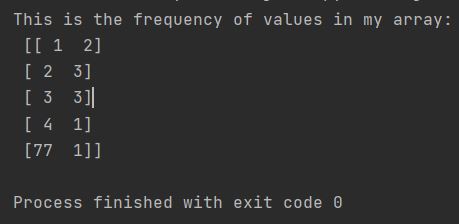Let’s learn how to calculate frequency of distinct values in Numpy array. We will use Numpy unique method to calculate that.

Numpy unique method
To calculate the frequency of values, use the unique function from NumPy with your array as the argument and return_counts=True.
Then I created variable unique_values and using asarray function created new array with the values and corresponding frequencies.
import numpy as np
my_array = np.array([1, 1, 2, 2, 2,
3, 3, 3, 4, 77])
unique, counts = np.unique(my_array, return_counts=True)
unique_values = np.asarray((unique, counts)).T
print(f"This is the frequency of values"
f" in my array: \n {unique_values}")

Python printed out frequency of values. As you can see in my array I had 1, 2, 3, 4 and 77. In second column Python returned the number of these values.
How to calculate the frequency of distinct values in a sorted array?
Sorting the array before calculating the frequency can improve performance, especially with large datasets. This is because np.unique can take advantage of the sorted order to compute counts more efficiently.
For example, the following code:
import numpy as np
my_array = np.array([1, 2, 2, 3, 3, 3, 4, 77])
sorted_array = np.sort(my_array)
unique_values, counts = np.unique(sorted_array, return_counts=True)
print("Unique values:", unique_values)
print("Counts:", counts)
np.sort(my_array): Sorts the array in ascending order. The sorted array is then passed to np.unique with return_counts=True. The counts correspond to the number of times each unique value appears in the array.
Alternatively, if you’re working with pandas Series or DataFrames, you can use value_counts directly.
